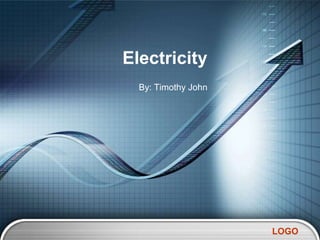
Electricity
- 1. Electricity By: Timothy John LOGO
- 2. Static Electricity Static electricity refers to the build-up of electric charge on the surface of objects. The static charges remain on an object until they either bleed off to ground or are quickly neutralized by a discharge. LOGO
- 3. More Of Static Electricity Although charge exchange can happen whenever any two surfaces come into contact and separate, a static charge only remains when at least one of the surfaces has a high resistance to electrical flow . LOGO
- 4. Electric Current Electric current is a The SI unit for flow of electric measuring the rate of charge through a flow of electric charge medium. This charge is typically carried by is the ampere, which moving electrons in is charge flowing a conductor such through some surface as wire. It can also be at the rate of carried by ions in one coulomb per an electrolyte, or by second. Electric both ions and electrons in a plasma. current is measured using an ammeter. LOGO
- 5. Potential Difference Voltage, otherwise known as electrical potential difference or electric tension (denoted ∆V and measured in volts, or joules per coulomb(C ) is the difference in electric potential between two points — or the difference in electric potential energy per unit charge between two points. LOGO
- 6. Deeper Into Potential Difference A voltage may represent either a source of energy, or it may represent lost or stored energy. A voltmeter can be used to measure the voltage between two points in a system; Voltage can be caused by static electric fields, by electric current through a magnetic field, by time-varying magnetic fields, or a combination of all three. LOGO
- 7. Calculation Voltage may be calculated as: LOGO
- 8. Resistance The electrical resistance of an electrical element is the opposition to the passage of an electric current through that element; the inverse quantity is electrical conductance, the ease at which an electric current passes. Electrical resistance shares some conceptual parallels with the mechanical notion of friction. The SI unit of electrical resistance is the ohm (Ω) LOGO
- 9. More On Resistivity For a wide variety of materials and conditions, the electrical resistance R is constant for a given temperature; it does not depend on the amount of current through or the potential difference (voltage) across the object. Such materials are called Ohmic materials. For objects made of ohmic materials the definition of the resistance, with R being a constant for that resistor, is known as Ohm's law. LOGO
- 10. How To Calculate Resistivity? V:Energy I: Current R: Resistivity LOGO
- 11. Resistor Color Code Resistors have color coded bands. Figure 0 1 2 3 4 5 6 7 8 9 Color Black Brown Red Orange Yellow Green Blue Violet Grey White Tolerance 5% Gold 10% Silver 20% No Band LOGO
- 12. Capacitors A capacitor is a passive two- terminal electrical component used to store energy in an electric field. Capacitors are widely used in electronic circuits for blocking direct current while allowing alternating current to pass, in filter networks, for smoothing the output of power supplies, in the resonant circuits that tune radios to particular frequencies and for many other purposes. LOGO
- 13. Capacitors Capacitors are widely used in electronic circuits for blocking direct current while allowing alternating current to pass, in filter networks, for smoothing the output of power supplies, in the resonant circuits that tune radios to A Polyester particular frequencies and Capacitor, used for CD player for many other purposes. and e.t.c. LOGO
- 14. Electric Power In many circuits,it is important to know the rate at which electrical energy is transferred into other forms of energy. Larger units of power is called as Megawatts LOGO
- 15. Calculating Electric Power P:Power(Measured in J/s or W) W: Watt(Measured in J) T:Time(Measured in Seconds) LOGO
- 16. Electricity In The Home Why Do Houses Use Parallel? -) To receive the same current and to still have energy running through them if one of the lamps were not functioning properly. The “Fuse” is used to prevent the malfunction of electrical equipments. LOGO
- 17. Dangers Of Electricity At Home 1. Electric Shocks > Electric shock occurs if current flows from an electric circuit through a person’s body. 2.Fire Risks >If flammable material is placed too close to a hot appliance, it may catch fire LOGO